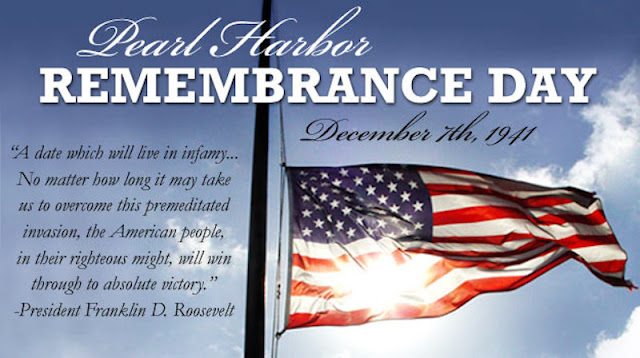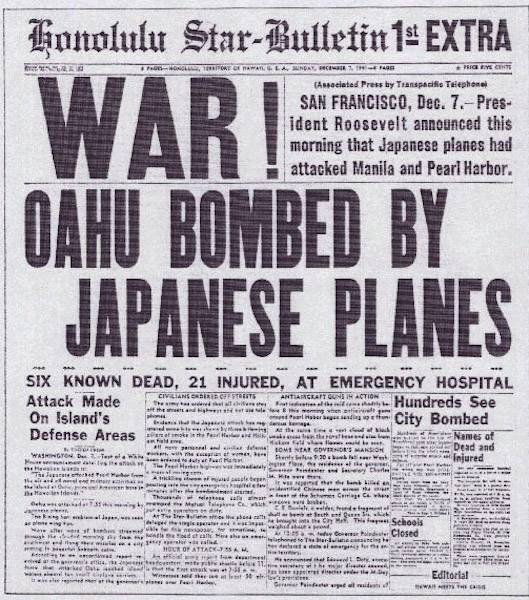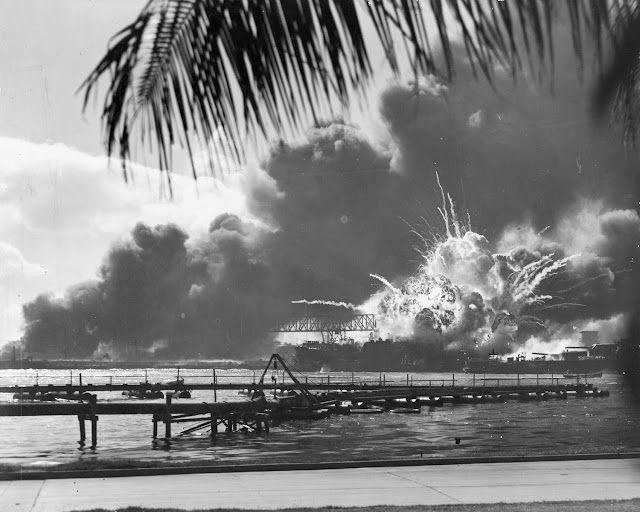On This Date In History
On December 7, 1941, at 7:55 a.m., Hawaii time, a Japanese dive bomber bearing the red symbol of the Rising Sun of Japan on its wings appears out of the clouds above the island of Oahu. A swarm of 360 Japanese warplanes followed, descending on the U.S. naval base at Pearl Harbor in a ferocious assault. The surprise attack struck a critical blow against the U.S. Pacific fleet and drew the United States irrevocably into World War II.
With diplomatic negotiations with Japan breaking down, President Franklin D. Roosevelt and his advisers knew that an imminent Japanese attack was probable, but nothing had been done to increase security at the important naval base at Pearl Harbor. It was Sunday morning, and many military personnel had been given passes to attend religious services off base. At 7:02 a.m., two radar operators spotted large groups of aircraft in flight toward the island from the north, but, with a flight of B-17s expected from the United States at the time, they were told to sound no alarm. Thus, the Japanese air assault came as a devastating surprise to the naval base.
Much of the Pacific fleet was rendered useless: Five of eight battleships, three destroyers, and seven other ships were sunk or severely damaged, and more than 200 aircraft were destroyed. A total of 2,400 Americans were killed and 1,200 were wounded, many while valiantly attempting to repulse the attack. Japan’s losses were some 30 planes, five midget submarines, and fewer than 100 men. Fortunately for the United States, all three Pacific fleet carriers were out at sea on training maneuvers. These giant aircraft carriers would have their revenge against Japan six months later at the Battle of Midway, reversing the tide against the previously invincible Japanese navy in a spectacular victory.
The day after Pearl Harbor was bombed, President Roosevelt appeared before a joint session of Congress and declared, “Yesterday, December 7, 1941, a date which will live in infamy, the United States of America was suddenly and deliberately attacked by naval and air forces of the Empire of Japan.” After a brief and forceful speech, he asked Congress to approve a resolution recognizing the state of war between the United States and Japan. The Senate voted for war against Japan by 82 to 0, and the House of Representatives approved the resolution by a vote of 388 to 1. The sole dissenter was Representative Jeannette Rankin of Montana, a devout pacifist who had also cast a dissenting vote against the U.S. entrance into World War I. Three days later, Germany and Italy declared war against the United States, and the U.S. government responded in kind.
The American contribution to the successful Allied war effort spanned four long years and cost more than 400,000 American lives.
Photograph taken from a Japanese plane during the torpedo attack on ships moored on both sides of Ford Island shortly after the beginning of the Pearl Harbor attack. View looks about east, with the supply depot, submarine base and fuel tank farm in the right center distance. A torpedo has just hit USS West Virginia (BB-48) on the far side of Ford Island (center). Other battleships moored nearby are (from left): Nevada (BB-36), Arizona (BB-39), Tennessee (BB-43) (inboard of West Virginia (BB-48)), Oklahoma (BB-37) (torpedoed and listing) alongside Maryland (BB-46), and California (BB-44). On the near side of Ford Island, to the left, are light cruisers Detroit (CL-8) and Raleigh (CL-7), target and training ship Utah (BB-31) and seaplane tender Tangier (AV-8). Raleigh (CL-7) and Utah (BB-31) have been torpedoed, and Utah (BB-31) is listing sharply to port. Japanese planes are visible in the right center (over Ford Island) and over the Navy Yard at right. U.S. Navy planes on the seaplane ramp are on fire. Japanese writing in the lower right states that the photograph was reproduced by authorization of the Navy Ministry.
The forward magazine of USS Shaw (DD-373) explodes during the second Japanese attack wave. At right is the bow of USS Nevada (BB-36), with a tug alongside fighting fires. Photographed from Ford Island, with a dredging line in the foreground. U.S. Naval History and Heritage Command Photograph.
Explosion of the forward magazines of USS Shaw (DD-373) in the floating drydock, after a bombing attack by Japanese planes on 7 December 1941. USS Nevada (BB-36), also hit by the attackers, is at right. Photographed from Ford Island, with USS Avocet (AVP-4) partially visible at left. Official U.S. Navy Photograph.
USS West Virginia (BB-48)
USS Cassin (DD-372) burned out and capsized against USS Downes (DD-375) after the attack.
USS Downes (DD-375), at left, and USS Cassin (DD-372), capsized at right, burned out and sunk in the Pearl Harbor Navy Yard drydock on 7 December 1941, after the Japanese attack. The relatively undamaged USS Pennsylvania (BB-38) is in the background.
USS Arizona (BB-39)
Aerial view of Battleship Row moorings on the southern side of Ford Island, 10 December 1941. Note dark oil streaks on the harbor surface, originating from the sunken battleships.
Japanese pilots head for their aircraft on the morning of the attack.
Japanese Navy Attack Plane taking off from an aircraft carrier on its way to Pearl Harbor on December 7, 1941.
Here's a drawing that was found in a wrecked Japanese plane following the attack on Pearl Harbor. The Japanese inscription at left reads: "Hear! The voice of the moment of death. Wake up, you fools." The comment at the top was written on the drawing later.
A view of Pearl Harbor looking southwest from above the hills towards the north. Taken during the Japanese raid from a Japanese aircraft, with anti-aircraft shell bursts overhead. Large column of smoke in lower center is from USS Arizona (BB-39).
Footage from a Japanese plane shows Pearl Harbor during the first wave of the attack. There appears to be a shock wave from a torpedo impact/explosion on the 3rd visible ship, USS West Virginia (BB-48) from the front in the foreground.
Attacked targets: 1: USS California (BB-44). 2: USS Maryland (BB-46). 3: USS Oklahoma (BB-37). 4: USS Tennessee (BB-43). 5: USS West Virginia (BB-48). 6: USS Arizona (BB-39). 7: USS Nevada (BB-36). 8: USS Pennsylvania (BB-38). 9: Ford Island NAS. 10: Hickam field. Ignored infrastructure targets: A: Oil storage tanks. B: CINCPAC headquarters building. C: Submarine base. D: Navy Yard.
2 - Photograph taken from a Japanese plane during the torpedo attack on ships moored on both sides of Ford Island shortly after the beginning of the Pearl Harbor attack. View looks about east, with the supply depot, submarine base and fuel tank farm in the right center distance. A torpedo has just hit USS West Virginia on the far side of Ford Island (center). Other battleships moored nearby are (from left): Nevada, Arizona, Tennessee (inboard of West Virginia), Oklahoma (torpedoed and listing) alongside Maryland, and California. On the near side of Ford Island, to the left, are light cruisers Detroit and Raleigh, target and training ship Utah and seaplane tender Tangier. Raleigh and Utah have been torpedoed, and Utah is listing sharply to port. Japanese planes are visible in the right center (over Ford Island) and over the Navy Yard at right. U.S. Navy planes on the seaplane ramp are on fire. Japanese writing in the lower right states that the photograph was reproduced by authorization of the Navy Ministry.
4 - Attacked targets: 1: USS California. 2: USS Maryland. 3: USS Oklahoma. 4: USS Tennessee. 5: USS West Virginia. 6: USS Arizona. 7: USS Nevada. 8: USS Pennsylvania. 9: Ford Island NAS. 10: Hickam field. Ignored infrastructure targets: A: Oil storage tanks. B: CINCPAC headquarters building. C: Submarine base. D: Navy Yard.
7 - Aerial view of Battleship Row moorings on the southern side of Ford Island, 10 December 1941. Note dark oil streaks on the harbor surface, originating from the sunken battleships.
USS Shaw Explosion - 1 - The forward magazine of USS Shaw (DD-373) explodes during the second Japanese attack wave. At right is the bow of USS Nevada (BB-36), with a tug alongside fighting fires. Photographed from Ford Island, with a dredging line in the foreground. U.S. Naval History and Heritage Command Photograph.
USS Shaw Explosion - 2 - Explosion of the forward magazines of USS Shaw in the floating drydock, after a bombing attack by Japanese planes on 7 December 1941. USS Nevada, also hit by the attackers, is at right. Photographed from Ford Island, with USS Avocet partially visible at left. Official U.S. Navy Photograph.
USS Cassin burned out and capsized against USS Downes after the attack.
USS Downes - 1 - USS Downes, at left, and USS Cassin, capsized at right, burned out and sunk in the Pearl Harbor Navy Yard drydock on 7 December 1941, after the Japanese attack. The relatively undamaged USS Pennsylvania is in the background.
USS Downes - 2 - The wrecked destroyers USS Downes and USS Cassin at the Pearl Harbor Navy Yard after the attacks were over.
J0 - Japanese pilots head for their aircraft on the morning of the attack.
J1 - Japanese Navy Attack Plane taking off from an aircraft carrier on its way to Pearl Harbor on December 7, 1941.
J2 - Here's a cartoon that was found in a wrecked Japanese plane following the attack on Pearl Harbor. The Japanese inscription at left reads: "Hear! The voice of the moment of death. Wake up, you fools."
J3 - A view of Pearl Harbor looking southwest from the hills towards the north. Taken during the Japanese raid from a Japanese aircraft, with anti-aircraft shell bursts overhead. Large column of smoke in lower center is from USS Arizona.
J4 - Footage from a Japanese plane shows Pearl Harbor during the first wave of the attack. There appears to be a shock wave from a bomb impact/explosion on the 3rd visible ship from the front in the foreground.










%20-%201941.jpg)



%20-%201941.jpg)
















No comments:
Post a Comment